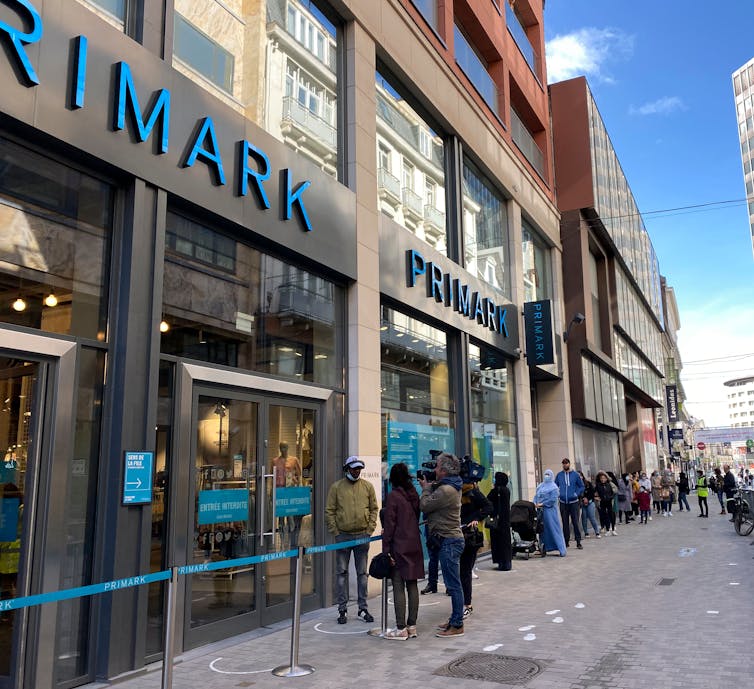Lisa Jack, University of Portsmouth and Regina Frei, University of Southampton
Irish fast-fashion retailer Primark has no plans to sell its clothes online. This is despite the company warning that lockdown store closures could cost it losses of more than £1 billion. The retailer has shut 305 of its 389 global stores – including 190 in the UK. Primark has just announced a 30% sales fall to £2 billion in the 16 weeks leading to January 2, adding that this loss could mean price rises.

While the retail giant has no online store to fall back on, the likes of online-only fashion retailers Asos and Boohoo, saw sales rise by 40% in the last four months of 2020. In fact, the Office for National Statistics says that online retail sales increased to 31.4% last November, compared with 28.6% reported in October – so it’s clearly unusual for Primark not to have a digital presence for shoppers.
Because Primark is one of the few high street fashion retailers without an online store, many of its customers have called for the business to adapt to the digital era and change this. But the store’s directors have no intention of doing so, citing the high costs of running an online business and the associated customer returns as the main reasons.
We have researched the growth of “buy online, return in store” and the true cost of returns. Our view is that Primark is right to be extremely cautious, as online shopping is designed to favour “time-poor but cash-rich” customers, not necessarily retailers. It’s a good example of how an online offering is not always the right option for retailers – and as we shall see, there are implications for social justice.
The problem with product returns
A good returns policy can attract customers and increase sales, but high rates of returns can wipe out any profits for a retailer. The average rate of returns is 8% for store sales but around 25% for online sales, rising to between 30% and 70% in the fashion world.
A recent report by the UK’s online retail association, IMRG, indicates that 31% of retailers found that managing online returns had a definite impact on profits. Some 33% reported increasing prices to cover the cost of returns.
In 2019, retailers had started to revise their policies and practices to combat these rates of return. In some cases, savings were made by simply enforcing the returns policy that they already had in place.
However, COVID-19 has negated most of this success. With stores closed, returns are coming through more expensive channels like post, courier and third-party collection points. There has also been an increase in fraud-related returns. The cost of these offset any gains from increased online sales.
If Primark were to launch an online store, Brexit would mean that it would need to decide whether to establish two separate returns distribution stores in Ireland and the UK. Running all returns through a single warehouse would generate additional paperwork around export classifications and increase transaction costs. But ultimately both solutions would be expensive and complicated due to import/export and VAT regulations.
Learning from rivals
In contrast, British clothing retailer Next has been successful online, though this not always straightforward. It began its directory business in 1988, shortly after opening its first stores, and then went online in 1999.
In 2018, Next had to make an accounting adjustment when it realised that the staffing and management cost of handling “click and collect” orders in-store was £0.89 per parcel and not the £0.57 previously assumed. With Primark selling clothes at lower prices than Next, it would likely not make a profit at all with click and collect.
Next’s online operation faces other challenges. In 2020, it said it would cost £12 million over two and a half years to modernise its website, which it described as “increasingly complex, unwieldy and expensive”. Additionally, the company reworked its distribution and inventory processes to turn around online orders more quickly.
We found that some retailers also face a problem of integrating their store and e-commerce channels. It is a major task to remodel the entire company IT infrastructure to accommodate the online business, and most settle for “bolt-ons”. Consequently, several of the businesses we studied used data from different systems to track refunds, returns and lost items. This is an issue Primark will have considered. And unlike Next, it had a poor experience of selling outside of the stores when it trialled selling through online retailer Asos a few years ago.
The implications of selling online
There is a perception that setting up and running a website should be easy. However, even small e-commerce owners quickly find that being online is not just a nice-to-have addition to their business.
To sell online, businesses need a gripping website with quality pictures. Returns usually occur when the item fails to match its online image or the information provided is incomplete or inaccurate. Additionally, the website needs a “back end” with very high functionality that links into inventory, logistics, customer accounts and finance systems.

Before you even start selling, that’s a lot of investment in design, photography, programming and testing. Then there are ongoing costs of maintenance, support, daily marketing and “click bait”. Online chat, call centres and customer support all need to be staffed, in addition to the warehouse operations dealing with online orders.
Most retailers find themselves setting up separate distribution warehouses to handle their online goods. Most major retailers have also set up separate distribution centres just to deal with returns. We found that accepting returns in store is the most cost-effective route.
But either way, there are still additional costs: even if there are no returns at all on a line or item, there is still a cost in maintaining the system just in case there is a return. This means that for items under a certain price, the handling costs are more than the income from reselling the item – a problem for low price propositions like Primark. Using our model, the cost of returns on a £5.00 item can be around £6.50.
Online shopping offers advantages for cash-rich, time-poor customers, whereas the time-rich, cash-poor often rely on stores like Primark. This raises the uncomfortable question of whether online shopping might be another sign of inequality in society – benefiting those with access to credit and IT, and who can afford to pay enough to cover the hidden costs of returns.
Lisa Jack, Professor of Accounting, University of Portsmouth and Regina Frei, Associate Professor in Operations and Supply Chain Management, University of Southampton
This article is republished from The Conversation under a Creative Commons license. Read the original article.












